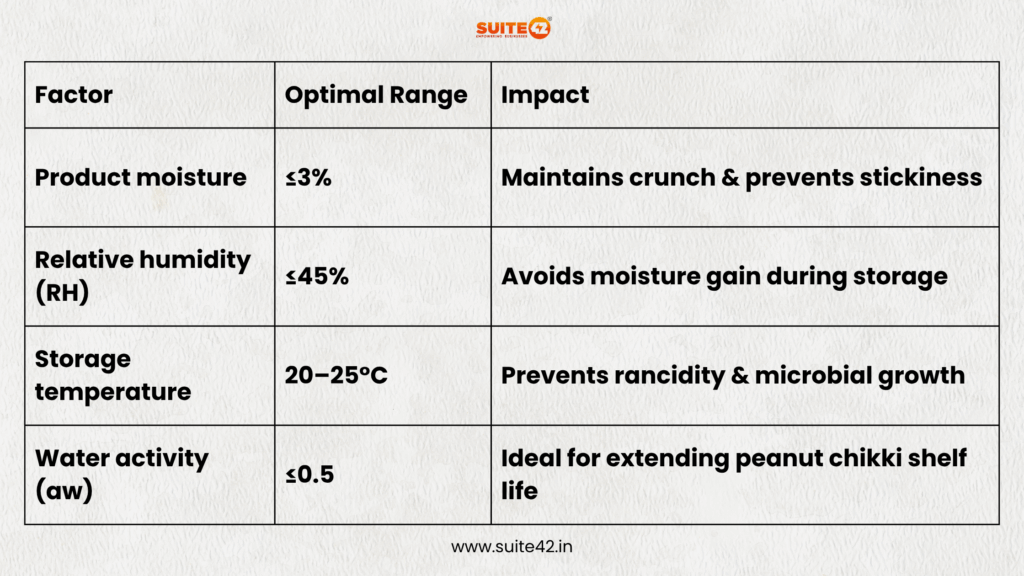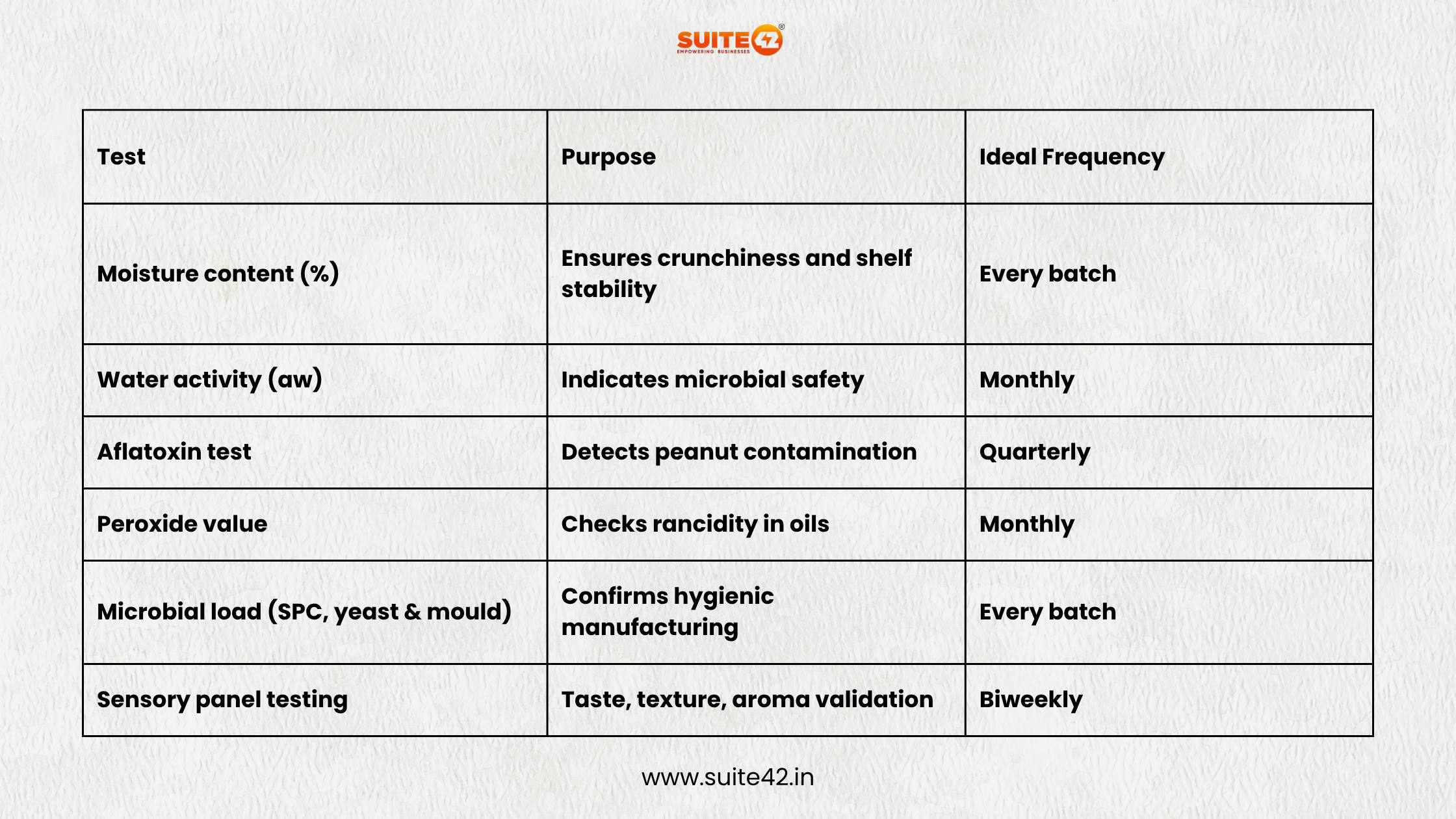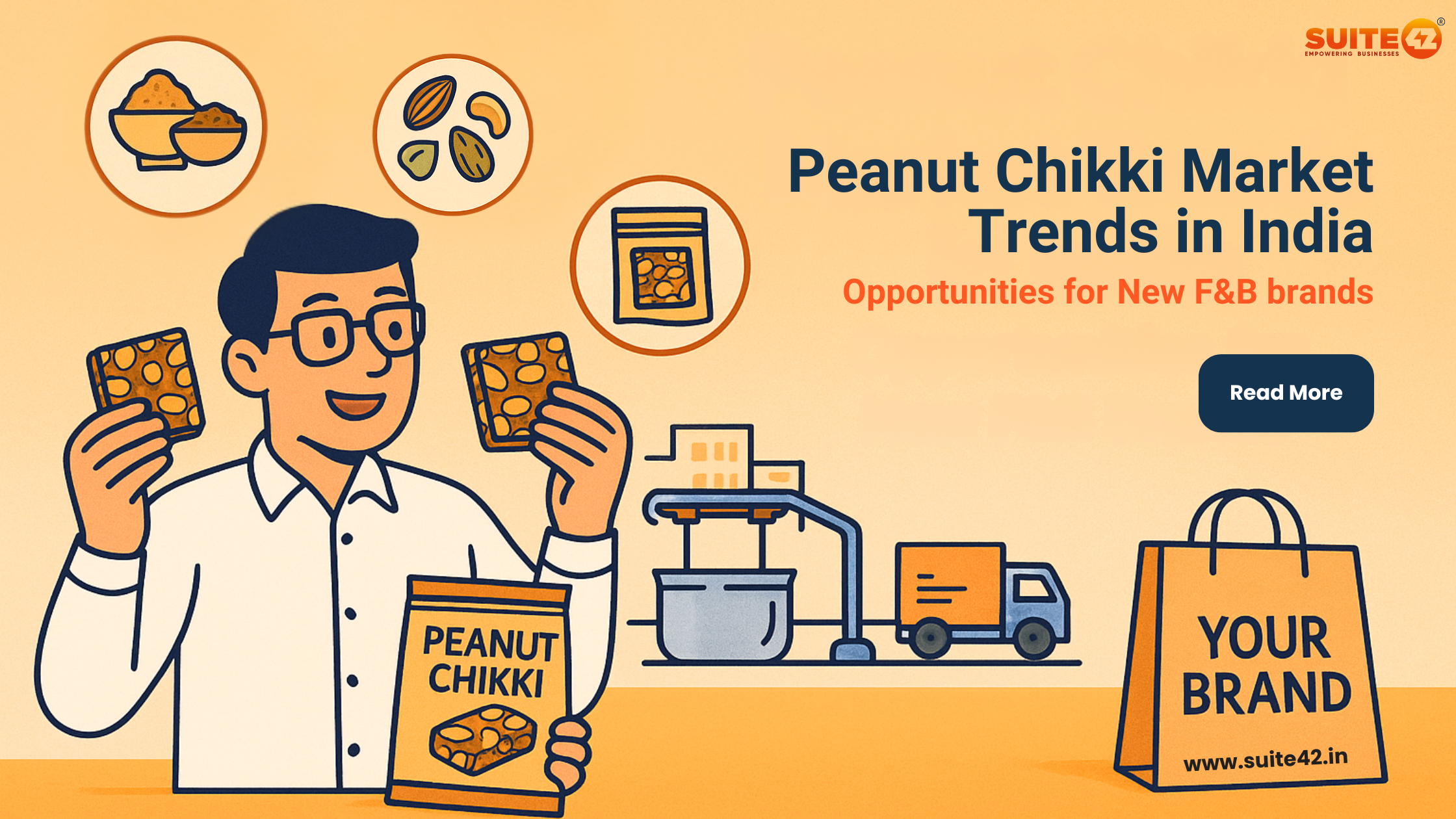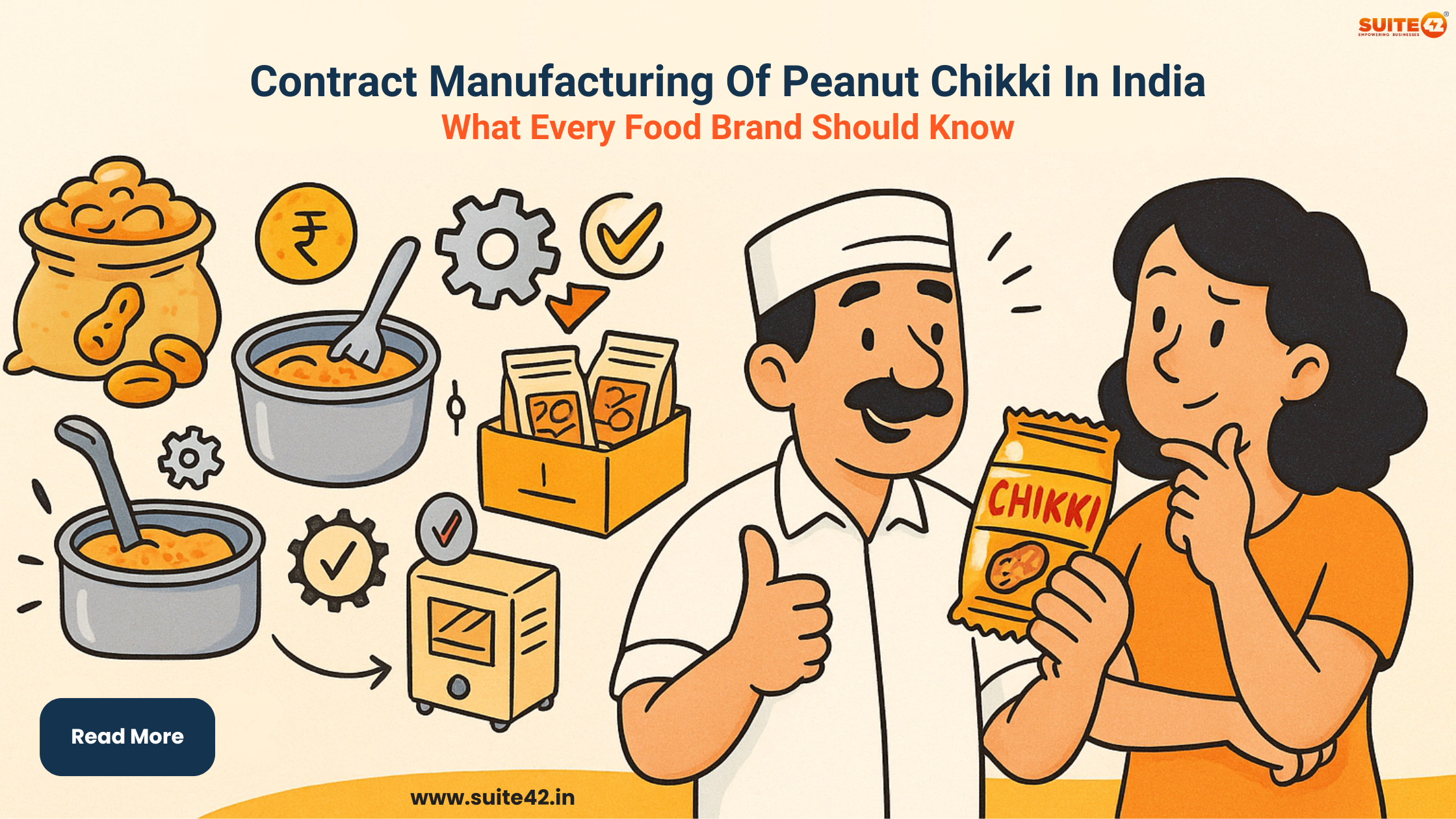
How to Ensure Quality & Shelf Life in Peanut Chikki Manufacturing
Introduction
Quality and shelf life are the backbone of any successful peanut chikki brand. Even the most delicious batch can fail commercially if it turns sticky, soggy, or loses its crunch on the shelf. For modern F&B entrepreneurs, mastering the science of stability is just as important as perfecting the recipe. In this blog, we’ll explore what determines the peanut chikki shelf life, how to control moisture and microbial activity, the role of packaging innovations, and the testing protocols that ensure consistent product quality across batches.
An article that might interest you: Peanut Chikki Product Development in India: From Recipe Trials to Commercial Scaling
Why Shelf Life Matters in Traditional Snacks
Traditional Indian snacks like peanut chikki were once made and sold fresh – but today, brands aim for 90 – 180 days of shelf stability to distribute nationwide and export globally.
That’s where modern food technology becomes essential.
Poor shelf life doesn’t just lead to spoilage; it impacts:
- Brand reputation (sticky or white-frosted chikkis cause consumer distrust)
- Retailer confidence (returns due to short life or packaging failure)
- Profit margins (higher wastage and QC rejections)
Maintaining a stable peanut chikki shelf life requires balancing traditional craftsmanship with industrial controls – from precise heating temperatures to moisture-proof packaging.
Ingredients That Affect Peanut Chikki Shelf Life Stability
Peanut chikki seems simple – just peanuts and jaggery – but ingredient chemistry drives its stability.
1. Peanuts:
- Peanuts contain 45–50% oil. Rancidity can occur if the raw material isn’t stored in cool, dry conditions.
- Always use fresh, low-moisture kernels (<8%), preferably from verified suppliers in Gujarat or Andhra Pradesh.
- Roasting enhances flavour but over-roasting (>170°C) accelerates oxidation.
2. Jaggery:
- Jaggery acts as both binder and preservative.
- Its Brix value (120–125°C) during caramelization determines binding strength and crunch.
- Excess heating leads to dark colour and burnt flavour; underheating causes sticky, short-lived chikkis.
3. Additives & Binders:
Modern clean-label chikkis may include natural stabilizers like gum arabic or liquid glucose to prevent crystallization. However, use must align with FSSAI guidelines.
4. Salt & Antioxidants:
Adding trace salt or permitted antioxidants (E300–E321) helps delay rancidity in roasted peanuts – crucial for long shelf life in warm, humid climates.
Tip: Document every ingredient supplier, grade, and batch for traceability – a key requirement under chikki manufacturing standards.
Moisture, Temperature & Storage Conditions
Moisture is the biggest enemy of chikki texture and longevity. Since both peanuts and jaggery are hygroscopic, even 1% excess moisture can ruin an entire batch.
Ideal Parameters

Control Measures
- Use dehumidifiers in production and packaging rooms.
- Store peanuts in nitrogen-flushed containers or vacuum packs.
- Avoid manufacturing in peak monsoon unless humidity control is in place.
- Periodically check weight gain tests (to detect moisture uptake over time).
Maintaining a stable processing environment is as important as ingredient quality – environmental consistency equals product consistency.
Role of Packaging in Peanut Chikki Shelf Life Extension
Packaging is your first line of defense against moisture, oxygen, and temperature fluctuations.
The right packaging can extend shelf life by 30–50% without altering the recipe.
Best Packaging Options
- Metalized BOPP / PET laminates – Excellent moisture barrier; ideal for single bars.
- Vacuum sealing – Removes oxygen, delays rancidity.
- Nitrogen flushing – Used in high-end snack lines for freshness retention.
- Multi-layer laminates with EVOH film – For exports needing 6+ month life.
Smart Packaging Practices
- Use food-grade adhesives and inks (to avoid off-flavours).
- Add desiccant pouches in family packs.
- Conduct drop and seal integrity tests for transport durability.
- For eco-conscious brands, explore compostable PLA films tested for barrier strength.
A quick rule: Choose your packaging material only after confirming your target shelf life, climate exposure, and retail channel – ambient retail needs different protection than e-commerce fulfillment.
Testing Protocols Every Food Entrepreneur Must Know
To meet chikki manufacturing standards, regular food quality testing is mandatory.
Testing validates the physical, chemical, and microbial stability of each batch before market dispatch.
Essential Quality Tests

Partner with NABL-accredited food labs in India for reliable analysis and compliance documentation. Retain samples for 6 months as proof of quality control under FSSAI audit guidelines.
Partnering with Labs & Manufacturers for Peanut Chikki Shelf Life Consistency
For emerging brands, maintaining batch-to-batch consistency is often the toughest challenge. The best way to achieve it is by collaborating with experienced food labs and contract manufacturers that already operate under verified quality systems.
Why this matters:
- Food labs help define standard operating parameters – cooking temperature, humidity tolerance, and shelf life validation.
- Contract manufacturers like Suite42 ensure these parameters are followed precisely at scale through process automation and in-line quality checks.
- Regular quality audits and sensory evaluations guarantee that your chikki tastes and performs the same in every batch, across every region.
By institutionalizing these controls, brands move from trial-and-error to data-driven consistency – the real differentiator in India’s competitive snack market.
Frequently Asked Questions (FAQs)
1. How long does peanut chikki shelf life lasts?
When manufactured and packaged correctly, peanut chikki typically lasts 3–6 months under ambient conditions. Premium packaging and moisture control can extend this up to 9 months.
2. How can I prevent my chikki from becoming sticky?
Maintain product moisture below 3% and store in environments with <45% relative humidity. Proper BOPP or PET packaging and controlled storage temperature (20–25°C) keep the chikki crunchy.
3. What role does packaging play in extending peanut chikki shelf life?
Packaging acts as a barrier against oxygen and humidity, which are primary causes of spoilage.
Metalized laminates, nitrogen flushing, and desiccant inserts help extend peanut chikki shelf life by preventing oxidation and moisture absorption.
4. How do I test my peanut chikki for quality?
Work with NABL-accredited food labs in India to test for:
- Moisture content
- Water activity (aw)
- Peroxide value (for rancidity)
- Microbial load
- Aflatoxins (in peanuts)
Routine testing ensures compliance and stability.
5. Can I outsource peanut chikki manufacturing without compromising quality?
Yes. Trusted partners like Suite42 provide end-to-end contract manufacturing with strict chikki manufacturing standards, batch traceability, and in-line quality testing – ensuring consistency even without owning a plant.
6. How does temperature affect peanut chikki shelf life?
High temperatures accelerate rancidity and texture softening. Storing chikkis between 20–25°C ensures longer shelf stability and taste retention.
7. What certifications or tests should my chikki pass before market launch?
Every batch should meet FSSAI labeling and safety guidelines, along with key quality metrics – moisture, microbial load, and packaging integrity. Maintaining retain samples for 6 months is also a compliance best practice.
An article that might interest you: How to Build a Successful Snack Brand in India: Expert Insights
Final Takeaway
In peanut chikki manufacturing, quality isn’t just a process – it’s precision.
Every percentage point of moisture, every degree of caramelization, and every micron of packaging barrier counts toward how long your product stays fresh on the shelf.
By implementing robust quality testing protocols, controlled production environments, and smart packaging solutions, F&B entrepreneurs can build chikki brands that last longer, travel farther, and earn consumer trust.






Leave a Reply